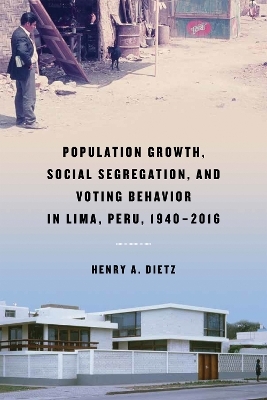
Population Growth, Social Segregation, and Voting Behavior in Lima, Peru, 1940–2016
Seiten
2019
University of Notre Dame Press (Verlag)
978-0-268-10613-3 (ISBN)
University of Notre Dame Press (Verlag)
978-0-268-10613-3 (ISBN)
As one of South America's larger capital cities, Lima, Peru, is remarkably understudied as a demographic and economic entity unto itself. In this important book, Henry Dietz presents an in-depth historical, sociological, and political analysis of a major Latin American city in the post–World War II period.
As one of South America’s larger capital cities, Lima, Peru, is remarkably understudied as a demographic and economic entity unto itself. In this important book, Henry Dietz presents an in-depth historical, sociological, and political analysis of a major Latin American city in the post–World War II period. Dietz examines electoral data for Lima’s districts from six censuses conducted between 1940 and 2007, framed against a backdrop of extensive demographic data for the city, to trace the impact of economic collapse and extended insurgency on Lima and its voters. Urbanization in Lima since World War II has at times been rapid, violent, and traumatic, and has resulted in marked social inequalities. Dietz looks at how equity across the city has not in general improved; Lima is today segregated both spatially and socially. Dietz asks if and how a high degree of segregation manifests itself politically as well as socially and spatially. Do urban dwellers living under profound and enduring social segregation consistently support different parties and candidates? As institutional political parties have faded since the 1990s and have been replaced by personalist movements, candidacies, and governments, Dietz explores how voters of different social classes behave. The result is a vital resource for researchers seeking well-contextualized information on elections and economics in Peru. This book will be of interest to scholars of politics or economics, especially in Latin America, but also to a much wider audience interested in how the developments in Lima, Peru, affect the global sociopolitical climate.
As one of South America’s larger capital cities, Lima, Peru, is remarkably understudied as a demographic and economic entity unto itself. In this important book, Henry Dietz presents an in-depth historical, sociological, and political analysis of a major Latin American city in the post–World War II period. Dietz examines electoral data for Lima’s districts from six censuses conducted between 1940 and 2007, framed against a backdrop of extensive demographic data for the city, to trace the impact of economic collapse and extended insurgency on Lima and its voters. Urbanization in Lima since World War II has at times been rapid, violent, and traumatic, and has resulted in marked social inequalities. Dietz looks at how equity across the city has not in general improved; Lima is today segregated both spatially and socially. Dietz asks if and how a high degree of segregation manifests itself politically as well as socially and spatially. Do urban dwellers living under profound and enduring social segregation consistently support different parties and candidates? As institutional political parties have faded since the 1990s and have been replaced by personalist movements, candidacies, and governments, Dietz explores how voters of different social classes behave. The result is a vital resource for researchers seeking well-contextualized information on elections and economics in Peru. This book will be of interest to scholars of politics or economics, especially in Latin America, but also to a much wider audience interested in how the developments in Lima, Peru, affect the global sociopolitical climate.
Henry Dietz is professor emeritus in the Department of Government and is a University Distinguished Teaching Professor at the University of Texas at Austin. He is the author and editor of numerous books, including Urban Poverty, Political Participation, and the State: Lima, 1970–1990.
Lima 1940-2007: An Analytic Framework and Some Background to 1940
Lima 1940
Lima 1961
Lima 1972
Lima 1981
Lima 1993
Lima 2007
Discussion and Conclusions
References/Bibliography
| Erscheinungsdatum | 11.09.2019 |
|---|---|
| Zusatzinfo | 6 Maps; 6 Halftones, black and white |
| Verlagsort | Notre Dame IN |
| Sprache | englisch |
| Maße | 152 x 229 mm |
| Gewicht | 507 g |
| Themenwelt | Geisteswissenschaften ► Geschichte ► Regional- / Ländergeschichte |
| Sozialwissenschaften ► Politik / Verwaltung ► Staat / Verwaltung | |
| Sozialwissenschaften ► Soziologie ► Empirische Sozialforschung | |
| Wirtschaft ► Volkswirtschaftslehre ► Makroökonomie | |
| ISBN-10 | 0-268-10613-4 / 0268106134 |
| ISBN-13 | 978-0-268-10613-3 / 9780268106133 |
| Zustand | Neuware |
| Informationen gemäß Produktsicherheitsverordnung (GPSR) | |
| Haben Sie eine Frage zum Produkt? |
Mehr entdecken
aus dem Bereich
aus dem Bereich


